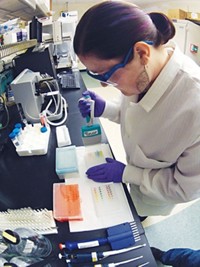Advertisement
Grab your lab coat. Let's get started
Welcome!
Welcome!
Create an account below to get 6 C&EN articles per month, receive newsletters and more - all free.
It seems this is your first time logging in online. Please enter the following information to continue.
As an ACS member you automatically get access to this site. All we need is few more details to create your reading experience.
Not you? Sign in with a different account.
Not you? Sign in with a different account.
ERROR 1
ERROR 1
ERROR 2
ERROR 2
ERROR 2
ERROR 2
ERROR 2
Password and Confirm password must match.
If you have an ACS member number, please enter it here so we can link this account to your membership. (optional)
ERROR 2
ACS values your privacy. By submitting your information, you are gaining access to C&EN and subscribing to our weekly newsletter. We use the information you provide to make your reading experience better, and we will never sell your data to third party members.
Environment
Toxicity Tests Sans Animals
Cosmetics firm L’Oreal is working with EPA to validate a high-througput screening system
by Britt E. Erickson
March 19, 2012
| A version of this story appeared in
Volume 90, Issue 12
Cosmetic company L’Oréal has committed $1.2 million to help EPA’s Office of Research & Development (ORD) advance its high-throughput chemical screening system called ToxCast. As part of the agreement, EPA will test 20 chemicals found in L’Oréal products using ToxCast to determine whether the system can reliably predict the chemicals’ toxicity. The chemicals include dyes and surfactants that are commonly used in cosmetics.
ToxCast was developed to rapidly predict toxicity, EPA says, including cancer and reproductive and developmental effects. It relies on models developed from the results of hundreds of biological assays. The system has been validated with hundreds of pesticides and other chemicals with extensive animal toxicity data. ToxCast “has now gotten to the point of maturity where within the agency we are starting to consider using it in regulatory decisions,” David Dix, acting director of EPA’s National Center for Computational Toxicology within ORD, said at a March 12 briefing.
“We are testing thousands of chemicals in ToxCast,” Dix noted. “This will allow us to understand how these chemicals interact with the biology of human cells and tissues and to predict the potential hazard,” he said.
The ultimate goal of ToxCast is to reduce the use of time-consuming, animal-intensive toxicity tests, EPA says. “We stopped animal testing of finished products in 1989,” said Patricia Pineau, scientific communications director for L’Oréal. Since then, the company has invested $800 million to promote alternative testing, including the use of reconstructed tissues, she noted. “We are focused on the full replacement of the animal models in all safety evaluations,” she said.



Join the conversation
Contact the reporter
Submit a Letter to the Editor for publication
Engage with us on Twitter